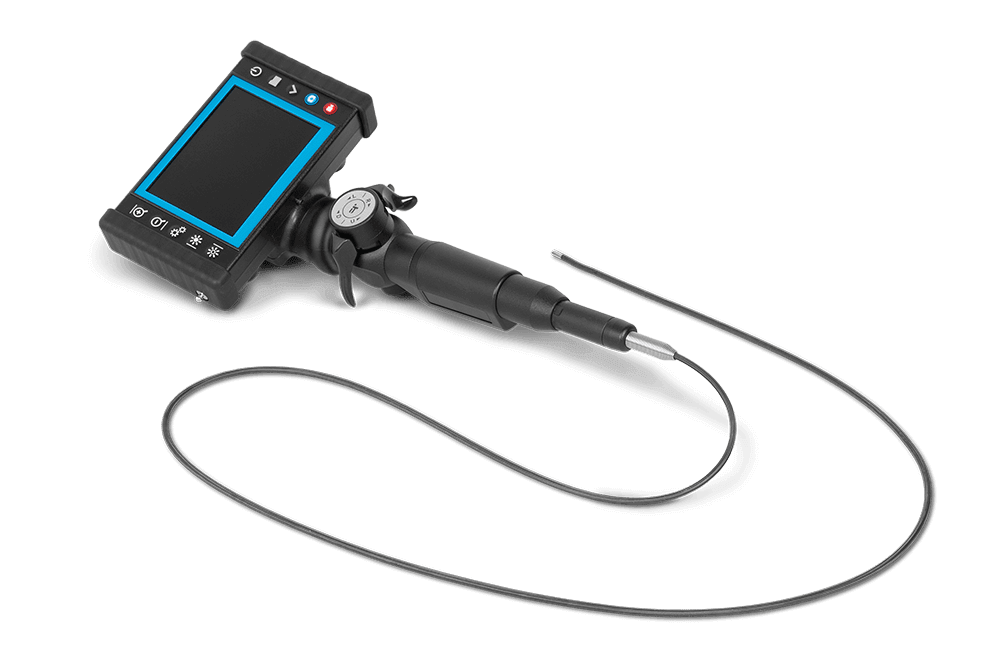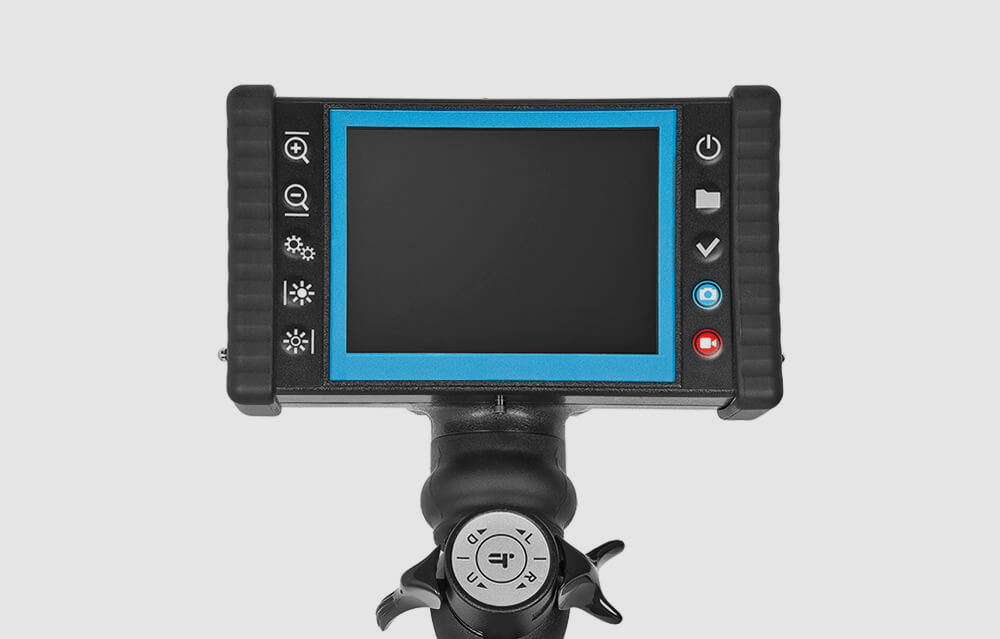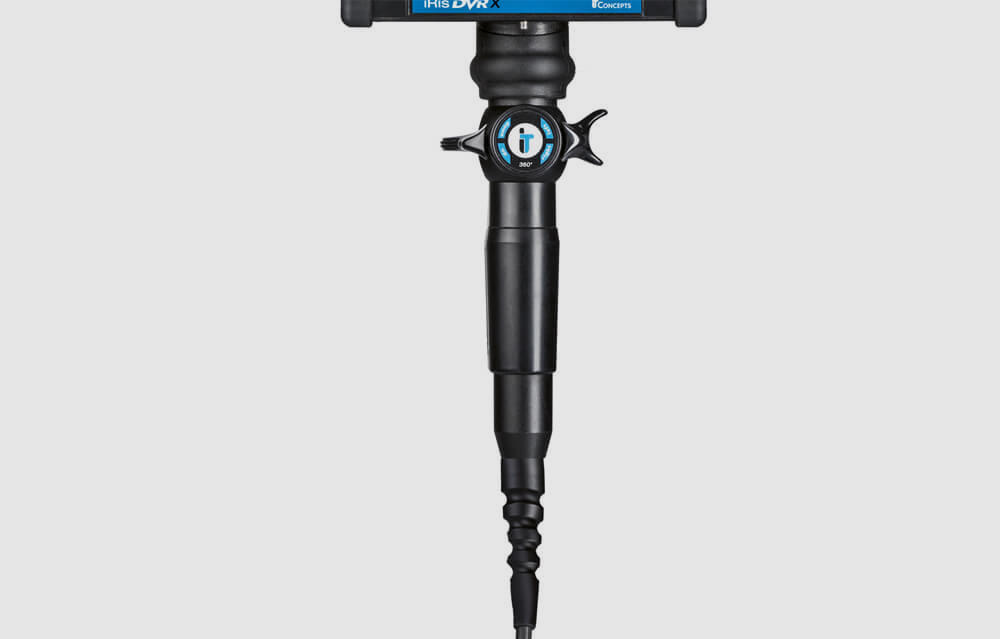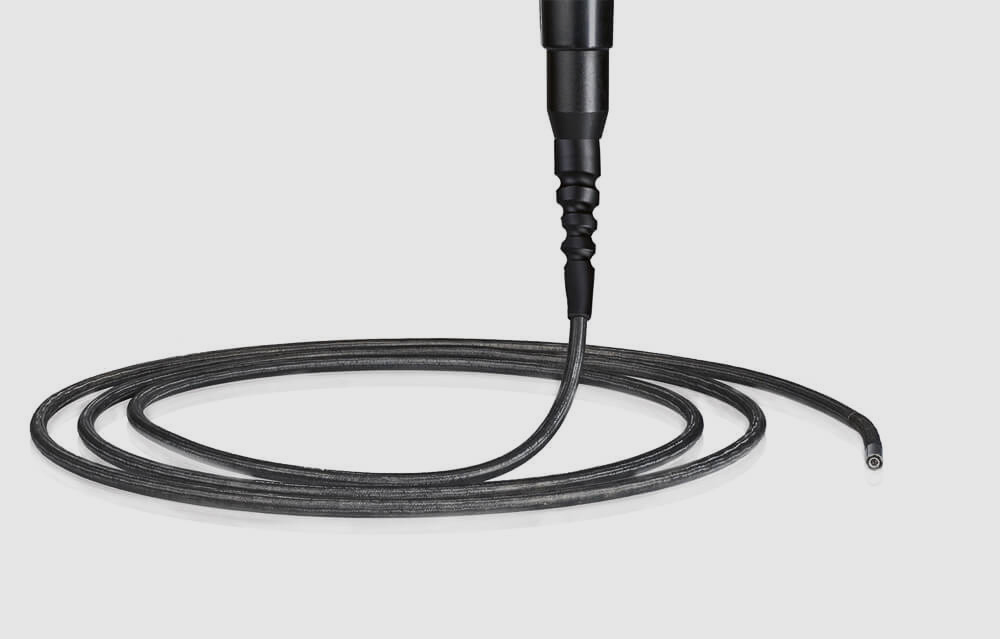
The VIDEOSCOPE XT is a truly industrial-grade borescope that has been designed for hazardous environments. This US-made inspection system has been tested and certified under MIL-STD 810G method 511.6 (explosive atmosphere) in accordance with UL standards for NFPA 70: class 1 division 2 requirements for hazardous locations. This borescope camera is also UL certified for Class I Division 2 hazardous locations. The system is Factory Mutual (FM) Compliant, CE Compliant, and built according to ISO 9001 standard.
This explosion-proof borescope camera is great for fuel tank inspections, police and military applications, customs and border protection, aviation and gas turbine, NDT, and power generation inspections.
This explosion-proof borescope camera is great for fuel tank inspections, police and military applications, customs and border protection, aviation and gas turbine, NDT, and power generation inspections.
EXPLOSION PROOF BORESCOPE CAMERA VIDEOSCOPE XT
Price
Prices are for the basic videoscope package and are subject to change. To find out the exact price of the set, write or call us.
The Explosion Proof Borescope VIDEOSCOPE XT is a handheld, all-in-one portable unit that consists of an integrated Imaging HUB, operational Handle with articulation levers, and a flexible insertion probe with an articulating tip
The Imaging HUB

- Large Integrated Display (5.0"/12.7 cm) with VGA 640x480 Resolution
- Built-in 3.5x Digital Zoom
- 3-stage Adjustable LED Illumination
- Cold Fiber Optic Light in the Handle Means no Spark from LED in Explosive Environments
- Rechargeable Battery
- 32,000 Images or 500 hours of Video Can be Stored on 32GB SDHC Card
- Text Generator to Mark Captured Files
- Comparative Measurement
- Rubberized Protective Bumper
+ Full Specifications
Operational Handle

- ± 90° Rotatable Display Unit, alt. ±90° Rotatable Scope Handle
- Ergonomic Construction with One-touch Image Capture Button
- Two Mechanical Levers for Precise Articulation Control
Insertion Probe

• Working Length from 1.5 meters (4.9 ft) up to 10 meters (33 ft)
• Diameter: 4.0 mm (0.16") or 6mm (0.24") or 8mm (0.314")
• High-res. Advanced CMOS Camera, with 90-degree FOV
• 4 Way Tip Articulation with 360° Rotation
• Durable Tungsten-braided Probe
• Water-proof up to 14.7 psi
• Heat-resistant up to 176° F (+80°C) or 284° F (140°C) < 5 Minutes
• Diameter: 4.0 mm (0.16") or 6mm (0.24") or 8mm (0.314")
• High-res. Advanced CMOS Camera, with 90-degree FOV
• 4 Way Tip Articulation with 360° Rotation
• Durable Tungsten-braided Probe
• Water-proof up to 14.7 psi
• Heat-resistant up to 176° F (+80°C) or 284° F (140°C) < 5 Minutes
+ Full Specifications
Fiberscope.net is an authorized dealer of Explosion Proof Videoscope XT
from It Concepts Imaging Solutions
from It Concepts Imaging Solutions
In the Box
Videoscope Unit
Battery
Battery Charger
Power Adapter
SD Memory Card
User's manual
Need advice? Ask our technical consultants who know the subject. They will answer your questions and help to scout out the best inspection solution for your application.

Questions and Answers
- Is this an intrinsically safe borescope camera? What is the difference between an explosion-proof and intrinsically safe borescope?The terms "explosion-proof" and "intrinsically safe" are both classifications of equipment suitable for use in hazardous environments
The difference is that an Explosion-proof (Ex) borescope has to be well sealed to contain any explosion originating within its housing and prevent sparks from within its housing from igniting vapors, gases, dust, or fibers in the air surrounding it.
Whereas Intrinsically Safe (IS) means that the probe is made using materials that limit energy, electrical and thermal, to a level below that required to ignite a specific hazardous atmospheric mixture. In simple terms, these devices are designed in such a way that they can't produce a spark that could ignite an explosive mixture, even in fault conditions.
As of our knowledge, at the present moment, there's no intrinsically safe video borescope available on the market.
This specific camera is not intrinsically safe; it is UL, MIL-STD-810G, and ATEX rated for an explosive atmosphere. - Are the MIL-STD 810G method 511.6, UL Class 1 Division 2, and ATEX Zone 2 certifications equal?The MIL-STD 810G Method 511.6, UL Class 1 Division 2, and ATEX Zone 2 certifications each represent different standards intended to regulate equipment for use in hazardous environments. While they all relate to safety in hazardous environments, they are not strictly equivalent, as they are developed by different bodies and are meant to address different types of hazards and operational conditions. Here's a brief overview of each:
MIL-STD 810G Method 511.6: This U.S. Military Standard defines the test methods for evaluating how well a device can handle operating in an environment where explosive atmospheres could be present. The testing procedures and requirements are extremely rigorous.
UL Class 1 Division 2: This is a safety standard set by Underwriters Laboratories (UL) for equipment intended to be used in places where a hazardous atmosphere is not normally present but could occur under abnormal conditions.
ATEX Zone 2: This is a certification based on the European ATEX directive, and it refers to a place in which an explosive atmosphere consisting of a mixture with air of dangerous substances in the form of gas, vapor, or mist is not likely to occur in normal operation but, if it does occur, will persist for a short period only.
While these certifications all deal with safety in hazardous environments, their requirements and the environments they apply to are not identical. To determine which certification is necessary for a specific device or application, it's important to understand the specific requirements of the environment and the local regulations and often to consult with a safety expert. - If the explosion-proof borescope model is certified for use in explosive atmospheres, does it mean it is protected over its lifespan?When an explosion-proof video borescope is certified for use in explosive atmospheres, it means the device meets rigorous standards and has passed stringent testing to ensure that it can safely operate in such environments. However, this certification does not automatically guarantee protection over the device's entire lifespan.
The device's safety can be affected by wear and tear, environmental conditions, misuse, and lack of maintenance. Therefore, regular inspections, appropriate usage, and good maintenance practices are vital to ensuring that the video borescope remains safe and functional throughout its lifespan. - Do I need specific training or a license to use an explosion-proof borescope?Generally, no special license is required to operate an explosion-proof borescope. However, operators are expected to have appropriate training to use such devices, particularly in hazardous environments, safely.
Also, it's important to note that regulations can vary by country, state/province, or industry. Therefore, we recommend contacting your local occupational safety and health administration or equivalent authority for the most accurate and up-to-date information. - Can explosion-proof borescopes be submerged in liquids or used in wet environments?Our video borescopes have waterproof insertion probes that can safely function in wet or submerged environments. Nevertheless, it is crucial to verify each model's specific ratings and limitations. Please feel free to ask our sales representative for more details.
- Are explosion-proof borescopes difficult to use?These borescopes are designed to be user-friendly. They come with ergonomic handheld articulation control and an intuitive interface. However, you can always contact our technical sales support with any questions.
- Where these videoscopes are made? How good is image quality?Our explosion-proof video borescopes are proudly made in the USA using precise German optics. They offer high-quality imaging and powerful illumination systems to provide clear visuals in dark environments.
- Is this a Food Grade Approved product? I see ATEX, but not Food grade compliance.This camera is not specifically rated for Food Grade. However, I know it is being used in some food processing plants. This unit can be safely cleaned with industrial-grade cleaning solutions. Please contact us if you have further questions at +1-877-613-2210
Do you have any questions?
They trust this videoscope for their visual inspection work








Multimedia
Explosion Proof Borescope with 4mm Insertion Probe Inspection Video Sample
UL Class 1 Division 2 Certified Borescope Camera VIDEOSCOPE-XT Video Sample
The Borescope's High-Quality Images
The exp-proof video borescope produces clear, high-resolution images, ensuring reliable and accurate detection. This enhances the user's ability to make informed decisions and maintain important systems.
Reviews
«Explosion Proof Videoscope XT Evaluation»
This purchase has been very beneficial in many ways.
Being able to use this device in Hazardous locations.
The functionality of the Device. Capturing Video and Photos to SD storage card
The durability of the camera lens.
Reducing Downtime on meter run inspections.
Documenting capabilities of Inspections for reports.
The Videoscope XT gives us the ability to quickly inspect orifice and ultrasonic meter tubes to determine if we have possible debris causing flow issues. This process before would require substantial downtime to pull apart flanges and/or remove inspection caps now we can open a ¾ to 1" ball valve snake the camera in and inspect those runs with little downtime and also have inspections documented by photos and or video docs.
Written by James Staten 10/30/2018
This purchase has been very beneficial in many ways.
Being able to use this device in Hazardous locations.
The functionality of the Device. Capturing Video and Photos to SD storage card
The durability of the camera lens.
Reducing Downtime on meter run inspections.
Documenting capabilities of Inspections for reports.
The Videoscope XT gives us the ability to quickly inspect orifice and ultrasonic meter tubes to determine if we have possible debris causing flow issues. This process before would require substantial downtime to pull apart flanges and/or remove inspection caps now we can open a ¾ to 1" ball valve snake the camera in and inspect those runs with little downtime and also have inspections documented by photos and or video docs.
Written by James Staten 10/30/2018
The System Full Description
- Industrial Grade Explosion Proof Borescope Camera
- Tested Under MIL-STD 810G method 511.6 (explosive environment)
- UL Certified for Class I Division 2 Hazardous Locations
- Factory Mutual (FM) Compliant
- CE Compliant
- ISO 9001
- Working Length from 1.5 meters (4.9 ft) up to 10 meters (33 ft)
- Diameter: 4.0 mm (0.16") or 6mm (0.24") or 8mm (0.314")
- High-resolution CMOS Camera, with 90-degree FOV
- Large Integrated Display (5.0"/12.7 cm) with VGA 640x480 Resolution
- Built-in Digital Zoom
- 3-stage Adjustable LED Illumination
- Cold Fiber Optic Light in the Handle Means no Spark from LED in Explosive Environments
- 4 Way Tip Articulation with 360° Rotation
- Rechargeable 6h Battery
- 32,000 Images or 500 hours of Video Can be Stored on 32GB SDHC Card
- Portable, Robust, Durable Set in a Hard Plastic Carrying Case
- Made in the USA
The explosion-proof borescope camera VIDEOSCOPE-XT is great for fuel tank inspections, police and military applications, customs and border protection, aviation and gas turbine, NDT, and power generation inspections.
This VIDEOSCOPE-XT inspection system is a full set, with a built-in monitor and integrated design. These units feature a great color CMOS camera chip in the tip of the probe, which will provide you with a small bend radius to access tight areas or corners. The camera chip has a 90-degree field of view, 4-way tip articulation, with 360-degree rotation, controlled via 2 knobs on the ergonomic handle for easy one-handed operation. The extra powerful LED light is located in the handle, so there is no chance of a spark in explosive environments, and it has 3-step intensity control. The live image is displayed on a large 5" color TFT monitor, with image and video capture to an SD memory card. These units also feature digital zoom, text input for captured files, comparative measurement, and a rechargeable battery for portable use.
The VIDEOSCOPE-XT explosion proof borescope cameras are available in a 4mm (0.16") diameter probe with standard lengths of 1.5 meters (4.9 feet) to 4 meters (13.1 feet), or there are larger 6mm (0.2.4") and 8mm (0.314") diameter probes with lengths from 1.5 meters (4.9 feet) to 10 meters (33 feet), with full tip articulation.
Note: VIDEOSCOPE-XT is a specially ordered product. Conditions apply. Call for details.
*To learn more about explosive atmosphere specifications read this page
Explosive Atmosphere and Visual Inspection
What is an explosion-proof borescope, and what are its applications in various industries?
An explosion-proof borescope is a specialized visual inspection device designed to operate safely in potentially hazardous environments where there is a risk of explosion due to the presence of flammable gases, vapors, or dust. These borescopes are constructed using materials and components that prevent the ignition of the surrounding atmosphere. To ensure their safe use in such environments, they are officially certified to meet specific safety standards and regulations, such as UL, ATEX, MIL-STD 810G.
-
Oil and gas
Explosion-proof video borescopes are used for inspecting pipelines, storage tanks, valves, and other components in refineries, offshore drilling platforms, and production facilities where explosive gases may be present. -
Petrochemical
These devices can be used to inspect equipment and infrastructure in chemical plants and processing facilities, where volatile chemicals and gases can create potentially explosive atmospheres. -
Power generation
Explosion-proof borescopes can be employed to inspect components in power plants, particularly those using natural gas or other combustible fuels, for signs of wear, damage, or contamination that could lead to equipment failure or an explosion. -
Law enforcement and border control
Explosion-proof borescope cameras allow law enforcement and border control officers to safely inspect suspicious packages or enclosed spaces for explosives, illicit substances, or hidden contraband without triggering a potential detonation. -
Food and beverage
Food and beverage: These borescopes are useful for inspecting equipment and storage facilities where explosive dusts, such as grain or sugar, may accumulate. -
AerospaceExplosion-proof borescopes can be used to inspect fuel systems, engines, and other components in aircraft, where combustible materials and fuels may create a hazardous environment. -
Mining and minerals
In mining operations, explosion-proof borescopes can be used to inspect equipment and infrastructure in areas where explosive gases or dust may be present, such as in coal mines or processing plants. -
Waste management
They can be employed to inspect equipment and facilities in waste treatment plants, landfills, and other waste management operations where flammable gases, such as methane, may accumulate.

